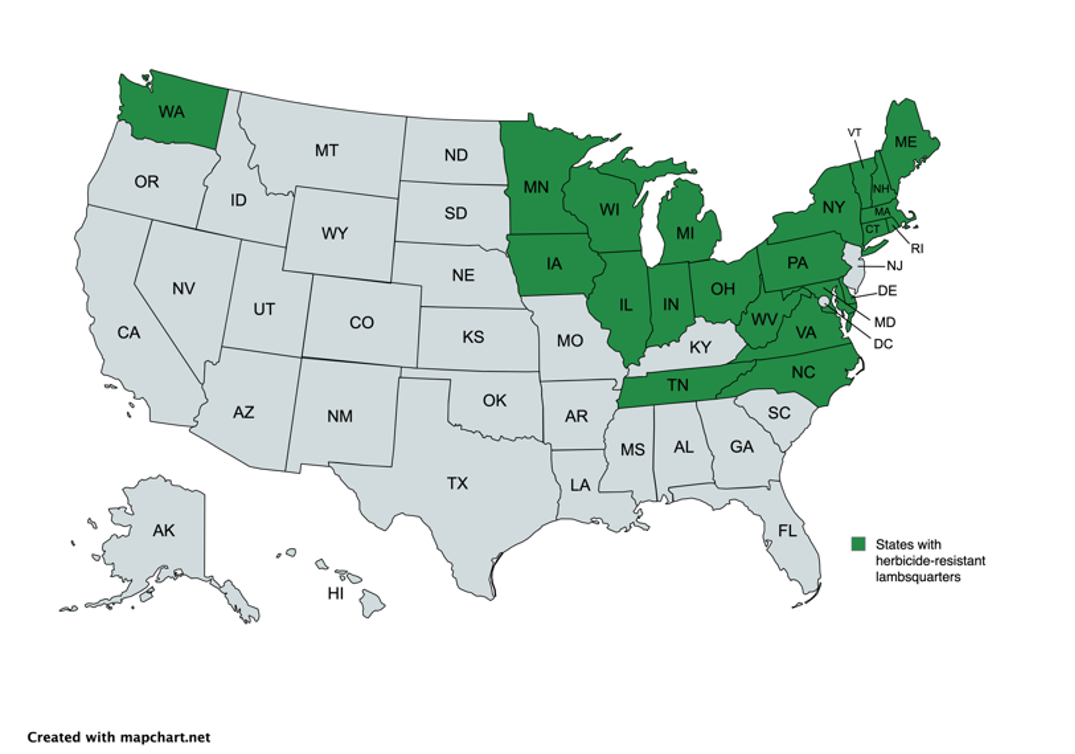Common lambsquarters is an early emerging summer annual weed that is prevalent in the Midwest. The emergence timing and rapid growth make lambsquarters extremely competitive with soybeans. In fact, one plant per foot of row can reduce soybean yield by 25%.1
- Common names: Common lambsquarters, lambsquarters, white goosefoot
- Scientific name: Chenopodium album L.
- Cotyledons: Two, linear cotyledons on seedlings
- Leaf shape: Triangle-shaped with toothed margins and white, grainy surface on mature plants
- Stems: Vary in color from green to reddish, smooth and grooved in texture
- Reproduction: Monoecious (having male and female attributes on the same plant)
- Flowers: Small, gray-green flowers clustered at stem tips
Fast Facts on Lambsquarters:
- Common lambsquarters is one of the earliest-emerging summer annual weeds. About 25% of the plants emerge prior to spring burndown applications or tillage. Peak emergence occurs in mid- to late spring with seeding typically in late summer into fall.1
- Lambsquarters grows quickly, with mature plants reaching up to 5 feet tall in the right conditions. The rapid growth leads to taller weeds earlier in the season, which can make effective herbicide control more difficult.
- The average lambsquarters plant produces about 72,500 seeds, with some producing up to 176,000 seeds.1
- Seed dormancy in common lambsquarters contributes to its success as a weed. Under certain conditions, it can remain viable in the soil for several decades.2
- Since the early 1970s, common lambsquarters has evolved resistance to two different herbicide sites of action: ALS inhibitors (Group 2) and photosystem II inhibitors (Group 5). According to WeedScience.org, herbicide-resistant lambsquarters has been found in more than 20 states.

Control Tips:
- A weed control program approach using burndown, preemergence and postemergence herbicides with multiple modes of action and residual activity can help keep lambsquarters under control.
- Encourage customers to start each spring with tillage and/or a burndown herbicide application.
- Following the burndown, customers should use a program approach that includes preemergence and postemergence applications with multiple modes of action and residual activity.
- Farmers also can use cultural practices to help control lambsquarters:1
- Planting in narrow rows and using higher seeding rates improve crop competitiveness with the weed.
- Planting later in the season and spring tillage are two practices that disrupt soil and help control young lambsquarters.
- Rotary hoeing can control lambsquarters when it’s under ¼ inch tall.
- Including small grains in crop rotation can keep the weed at bay.
1 United Soybean Board. 2024. Common Lambsquarters. https://iwilltakeaction.com/weeds/identification/common-lambsquarters/
2 Curran, B., et al. 2007. Purdue Extension. Biology and Management of Common Lambsquarters. https://ag.purdue.edu/btny/purdueweedscience/wp-content/uploads/2021/01/GWC11_Lambsquarters.pdf
FulTime® NXT and Keystone® NXT are Restricted Use Pesticides. The transgenic soybean event in Enlist E3® soybeans is jointly developed and owned by Corteva Agriscience and M.S. Technologies L.L.C. EverpreX®, FulTime NXT, Keystone NXT, Kyro™, Resicore®, Sonic® and SureStart® II are not registered for sale or use in all states. FulTime NXT, Keystone NXT, Kyro, Resicore and SureStart II are not available for sale, distribution or use in Nassau and Suffolk counties in the state of New York. Enlist Duo® ,Enlist One® herbicides are not registered for sale or use in all states or counties. Enlist Duo and Enlist One herbicides are the only 2,4-D products authorized for use with Enlist® crops. Consult Enlist® herbicide labels for weed species controlled.Contact your state pesticide regulatory agency to determine if a product is registered for sale or use in your state. ® Liberty is a registered trademark of BASF. Always read and follow label directions.

